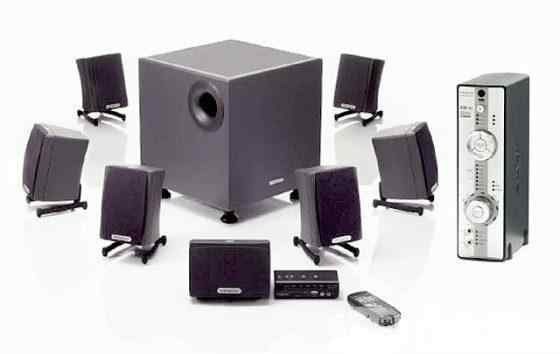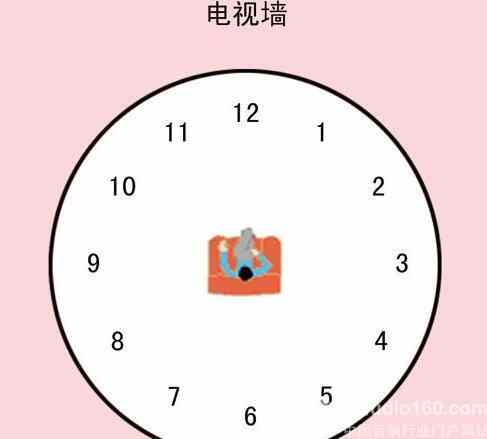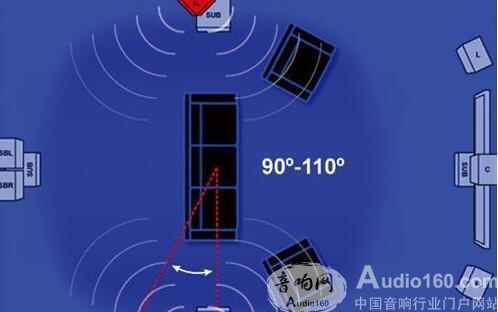Many users have been shocked after experiencing the 7.1-channel speaker, and they did not hesitate to purchase a 7.1-channel speaker. However, in fact, the placement of the 7.1-channel speaker is very particular, and it takes a lot of money to design it for a specialized organization. Now you only need to spend 10 minutes browsing the article to save the money.

Considering that most people's speakers are still in the "5.1" or even "2.1" era, before I talk about the placement of 7.1-channel speakers, I feel that it is necessary to explain the question "why use 7.1-channel speakers."
There are currently four camps in the multi-channel surround format: 5.1 for SACD, 5.1 for DVD Audio, DTS ES 5.1 and Dolby Digital EX 5.1. Among them, DTS ES 5.1 and Dolby Digital EX 5.1 are the multi-channel surround format used by movies. After the AV amplifier is used to decode the soundtrack of the DTS or Dolby Digital audio format, it usually adds DSP (Digital Surround Processing) sound field processing mode to make the sound field and sound color closer to the effect of the large theater. At this time, the high-end AV The amplifier converts the 5.1 channel to a 7.1 channel through a digital sound field processing program. Similarly, for DTS 5.1 and Dolby Digital 5.1 surround formats, the DSP can also convert it to 7.1 channels.
Some people may ask: "Where is the difference between 7.1 channel and 5.1 channel?" 7.1 channel uses two pairs of surround speakers to replace a pair of surround speakers in 5.1 channel. Imagine if there is no surround speaker behind you, the sound positioning will inevitably be biased, there is no stereoscopic feeling; instead, two surround speakers can be used to correct the phase difference, and the other six speakers can achieve a tight sound positioning. A sense of envelopment and space. It is no exaggeration to say that as long as the adjustment is right, the 7.1 channel charm may make you never want to go back to the 5.1 channel home theater.
Rear surround speakers need to be buried. Because 7.1-channel speakers are mainly used to enjoy movies, the wire should not be overly demanding. Generally, 200-core copper wire can be selected. When wiring, due to the large difference in the structure of different living rooms, it is necessary to determine the wiring method according to the specific situation. When embedding the wire, whether it is in the floor planer or on the wall, the speaker cable should be covered with a plastic sleeve or a yellow wax tube. Do not directly seal it with cement. It is worth mentioning that in addition to the two pairs of surround speakers need to embed the line, the front surround speaker, center speaker and subwoofer generally do not need to embed. If a TV cabinet is placed in the living room, you can hide the connection of these speakers behind the TV cabinet, so that it will not affect the appearance.

Wall hanging, or bracket?
Most of the surround speakers in the 7.1-channel speakers support the two ways of placing the wall and the bracket. It is also one of the focuses of the debate. In my opinion, as long as the speakers are placed correctly, these two placement methods have no significant effect on the overall sound. It is recommended that you choose according to the decoration of the living room and the arrangement of the speakers. If the decoration style is more complicated, or the surround speakers are far away from the wall, you can use the bracket method; the decoration is relatively simple, and the surround speakers are close to the wall, plus the speaker cable. It has also been buried, and it is naturally preferred to install the wall.
If you can't find a suitable bracket, consider customizing it according to your own speakers, but the cost will be relatively high. Nowadays, many speaker manufacturers will launch corresponding speaker brackets according to their products when producing speakers.
Users can go to the speaker store or the electronics store to buy a suitable speaker stand to install the surround speakers. It is worth mentioning that even for different models of the same brand of speakers, the respective brackets are likely to be different. Therefore, it is recommended that you understand the corresponding bracket model before purchasing.
7.1-channel speakers placed in actual combat speaker placement, although different from person to person, but also follow certain rules. For the sake of understanding, we may wish to indicate the orientation by the clock plane. Assume that the user's seat (ie “Emperor Positionâ€) is the center of the clock, which is 12 o'clock in front, 6 o'clock in the back, and 9 in the left. The direction of the clock is on the right side at 3 o'clock.


The center speaker and the front left/right surround speakers are shown in the figure. The center speaker is placed at 12 o'clock, and the front left/right surround speakers are placed at 11 o'clock and 1 o'clock respectively. Front left/right The surround speakers should form an angle of about 45° with the “Emperor Positionâ€. The center speaker and the front left/right surround speakers are mounted at the same height as possible, and are flush with the height of the ear when the user is sitting, in order to obtain the best sound field and correct vocal dialogue positioning.

If there is a TV or the like at this height that hinders the placement of the center speaker, it can be placed up or down at a distance of no more than 0.3 m, and then the radiation direction of the speaker can be adjusted. There is a need to correct a newcomer's mistakes. It is not right to place the center speakers of the front left/right surround speakers on a pair of parallel lines. The correct way is that the tweeters of the center speaker and the front left/right surround speakers should be aimed directly at the user's head.
The left/right surround speakers are left and right surround speakers at 9 o'clock and 3 o'clock respectively. They are located on both sides of the "Emperor's Position" and are 1 to 3 m apart. The two speakers are facing each other. How high is it necessary to surround the speaker? In fact, the height of the surround speakers does not have a too strict standard, but it must be noted that the diffusing sound of the surround speakers should be more directional than to create a rich surround atmosphere.

According to experience, if you use a common single-pole bookshelf as a surround speaker, the user sitting on the “Emperor Position†will prevail. The horizontal plane of the ear is about 30 degrees obliquely, which is the best height of the surround tweeter. The ground is between 1.8 and 2.2 meters. Since this is the edge of the diffusing corner of the dome tweeter, if the surround speaker is placed above this height, the high frequency loss is serious, many details are not heard, and the sense of space becomes narrow; if it is placed below this height, it will be high. The frequency of the direct sound is too strong and the sound field can not be opened, making people feel very unnatural.
Rear left/right surround speaker
The rear left/right surround speakers are at 7 o'clock and 5 o'clock respectively. The sounding surface of the speaker is facing straight ahead, and the distance to the "Emperor's Position" should not exceed the distance from the left and right side surround speakers to the user's head. In addition, the angle between the rear left/right surround speakers and the "Emperor" is preferably around 60°.
Subwoofer For subwoofers (commonly known as "subwoofers"), you should not rush to position, you need to set the low frequency crossover point of the AV amplifier. The 7.1-channel speakers used in this example are THX-certified, so all the crossover points need to be set at 80Hz. As for other subwoofers, you must set the crossover point for each channel based on the low frequency response of each speaker. Once the crossover point is set, the subwoofer can be placed. Since the low frequency below 80 Hz is almost non-directional, in theory, the subwoofer can be placed anywhere in the room at will. After continuous audition, the subwoofer in this example was placed on the right side of the "Emperor", which is 2 o'clock.
Write in the final speaker position and adjust whether it is in place, after all, use your own ears to "receive". You don't have to use a dedicated audition disc to play a few high-definition movies with DTS/DTS-HD, AC-3 or Dolby Digital sound. If the speaker is placed and debugged in place, it can clearly feel that the sound is positioned clearly, accurately, and clearly, the sound field is wide, the surround sound is rich, and the sense of presence is strong. Compared with the traditional 5.1-channel speaker, the 7.1 sound system built in this example creates a strong sound field surround, which gives the user a sense of immersiveness. It should be pointed out that the positioning method taught in this paper is not suitable for listening to pure music, because the rear left/right surround speakers are located behind the “emperor positionâ€, so the sound of some instruments is emitted from the back of the user, which is true to the performance. The environment has a big difference.
We are famous power factory in china.We mainly offer led switching power supply,dual outpout led switching power,IP67 led power,waterproof led power,IP67 Outdoor Power,IP20 Indoor Power,IP20 led power,Ultra thin led power,outdoor led power etc.They widely use for led strip light,led wall wash light,led
underwater light,led inground light,led spike light,etc.
Ip20 Ultra Slim Hcc L Power,Led Switching Power Supply,Ip20 Ultrathin Power Supply,Dual Output Led Switching Power
Jiangmen Hua Chuang Electronic Co.,Ltd , https://www.jmhcpower.com